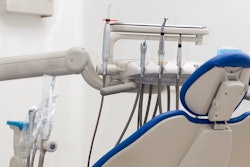
Dr. E, a general dentist in practice for more than 30 years, decided to take advantage of a change in her state's laws regarding dentists being permitted to provide sedation in conjunction with dental procedures by attending a weekend course on dental sedation management.
Dr. E maintained basic life support certification, as did one of her three dental assistants. Brochures in her office waiting room made it known that patients could now be provided with sedative medications, and a similar update was added to the practice's website.
A long-standing 73-year-old male patient, "Mr. Q," who was 5'10" tall, weighed 255 pounds, and had hypertension (treated with a beta blocker) and type 2 diabetes (treated with an oral hypoglycemic and diet), appreciated having all of his dentistry performed in one office setting by Dr. E, whom he had known for many years. Over time, she had provided him with treatment in nearly all phases of dentistry (fixed prosthodontics, periodontics, endodontics, and a mandibular advancement device for obstructive sleep apnea [OSA]).
 Dr. Marc Leffler.
Dr. Marc Leffler.Mr. Q was now in need of a maxillary implant-supported prosthesis because the fixed bridge abutment teeth had become increasingly periodontally involved. Working together, Dr. E and Mr. Q agreed on a plan which involved extracting the remaining upper teeth and placing an immediate maxillary denture, with implants to be placed at a later date.
With Dr. E now offering sedation dentistry, Mr. Q requested sedation for the extraction phase, and Dr. E agreed. An appointment was scheduled a month in advance, by which time the laboratory-fabricated denture would be ready. In preparation, the patient was told to refrain from taking anything by mouth after midnight and up to his 11:30 a.m. appointment.
Dr. E saw no need to obtain a medical consultation because she knew the patient quite well and believed that his health status had been unchanged for more than a decade. Mr. Q complied with every aspect of the pretreatment instructions he had been given.
The patient presented to the office on the morning of treatment, accompanied by his adult daughter. Dr. E seated her patient in a supplemental treatment room and gave him a 10 mg tablet of diazepam and a hydrocodone-acetaminophen tablet, with the goals of sedation and pain abatement by the time treatment would start about 30 minutes later. She told him to lay back in the chair and relax while she turned out the room lights and treated another patient.
Approximately 15 minutes later, she looked in on Mr. Q to find him sleeping and snoring loudly. But from the adjacent room, she soon heard the snoring abruptly stop, replaced by gurgling and what she would recall to be an "odd gasping sound."
Dr. E checked on her patient and found him unresponsive to her speaking or hand pressure. Because the supplemental room was generally not used for treatment but rather for examinations and postoperative checks, it was not equipped with oxygen, so she asked her assistant to bring in the centrally hooked-in nitrous oxide/oxygen setup from another room.
By the time the assistant was able to disassemble the equipment and attach an oxygen canister, an estimated six to seven minutes had elapsed. Dr. E finally applied 100% oxygen through a nasal mask, as she did not have a full face mask in the office, so she had no means to force the flow into Mr. Q's lungs.
There was no pulse oximeter available. While Dr. E had been trained in cardiopulmonary resuscitation techniques, the statute had not required (and she did not complete) advanced cardiac life support training, so there was neither a laryngoscope nor an endotracheal tube in the office.
At this point, Dr. E instructed a staff member to call 911. By the time paramedics arrived and transported him to a hospital, Mr. Q was pronounced dead.
Despite Mr. Q's age, an autopsy was performed due to the circumstances surrounding his death. Among the coroner's findings were that the patient had died of asphyxiation due to an obstructed airway and hypoxemia. His preexisting OSA (which was well-known to Dr. E but apparently was not adequately considered) played a significant role in the series of events coming to fruition.
Legal action
Shortly after Mr. Q's estate was in place, relatives hired an attorney who obtained Dr. E's office records, which were evaluated by a dentist anesthesiologist. Based on the anesthesiologist's review, the attorney wrote a letter to Dr. E in which he demanded a monetary settlement following a list of claimed acts/omissions of negligence that were claimed to have caused Mr. Q's death, including the following:
- Failure to obtain medical clearance
- Failure to directly monitor the patient after the delivery of sedative and narcotic medications
- Failure to consider and account for the patient's underlying conditions, which were specified as age, obesity, diabetes, OSA, and hypertension
- Failure to have training and knowledge regarding the use of resuscitative equipment
- Failure to have the necessary emergency equipment available and ready to use
- Failure to train office staff as to how to respond to medical emergencies
- Failure to contact emergency responders in a timely manner
The letter concluded with the threat that if the matter was not settled within a stated time period, the family would seek criminal prosecution of the dentist based on "gross negligence." (As an aside, this threat led to a disciplinary inquiry against the attorney.)
Because expert support for the dentist's actions could not be obtained, Dr. E's professional liability carrier reached a presuit settlement with the estate for an amount that took into account the patient's age and preexisting medical conditions. Dr. E was not criminally prosecuted, but she was sanctioned by her state's dental board.
Takeaways
I am reminded of my father's words many years ago after passing a road test and becoming a licensed driver: "Just because the state gave you a license to drive doesn't mean you know how to drive."
Similarly here, Dr. E had fulfilled the basic requirements of her state's regulations for the use of sedation in conjunction with dentistry, but that was demonstrated to be far less than what was needed to safeguard her patient under the circumstances of this case study. Dentists are wise to recognize and constantly uphold the concept that they must "do no harm" and, as a corollary, realize that the lawful ability to perform treatment does not equate to a technical or academic level of expertise to safely and properly perform that treatment.
Practicing within one's abilities means not only managing procedures but managing complications and knowing when not to engage in the first place, despite whatever pressures may be placed by external sources -- whether from patients or employers.
While it is fairly infrequent for the norms of dentistry to differ between states, the areas of enteral and parenteral sedation, as well as general anesthesia, are clear exceptions. Dentists who practice on the borders of neighboring states may be fully permitted to sedate their patients in one of their offices while strictly forbidden from doing so in another.
Therefore, dentists should become aware of what local laws do and do not allow, and they should periodically familiarize themselves with changes that come about in order to protect themselves and their patients. Organized dentistry groups often establish guidelines, but they do not establish local laws, and they do not have the ability to govern dental practice. Reliance on such guidelines alone may lead dentists astray.
The issue of obtaining medical consultation or clearance in advance of dental procedures has been a concern for years, and its need continues to grow as the population ages and more medical treatment solutions extend lifespans. Dentists are not expected to be as expert regarding medical issues as their physician colleagues, but dentists should know when to seek the input of treating physicians.
It should not bother physicians to assist in the dental health of their patients, but even if they appear to be inconvenienced by a question from a dental colleague, that cannot serve as an excuse for failing to obtain a needed consultation.
Good risk management dictates documentation whenever such a consultation takes place, ideally by a writing (letter, email) from the physician, but at least by way of a contemporaneous chart entry by the requesting dentist in which the physician is identified and the guidance is detailed.
When sedation is used by dentists, complete familiarity with all medications employed is an absolute. So, too, are the concepts of titration and dose to allow the patient to be adequately sedated, but not overly so, the latter situation greatly increasing risk.
In some patients, especially if they are older, sedatives and/or narcotics have been known to lessen a patient's drive to breathe, so caution must dictate. And the need to take, follow, and record vital signs cannot be ignored.
This case study involves a patient with numerous medical problems, some of which are generally addressed here. While all deviations from medical norms deserve due consideration, common conditions which are often seen as sources of malpractice suits include patients taking anticoagulants (bleeding concerns), patients with certain structural cardiac anomalies (potential need for antibiotic coverage), diabetes (increased infection risk and management of empty stomach while maintaining adequate circulating glucose levels in sedation/general anesthesia settings), OSA and obesity (airway concerns, especially with sedation/general anesthesia), osteoporosis (impacts of bisphosphonates), and uncontrolled hypertension (stroke concerns).
Careful medical history reviews and updates are critical to the sound medical stability of dental patients, whether sedated or not. As the old dental school adage goes, the teeth are connected to the body.
The final point here is to recognize that all dental team members have uniquely important roles in the safe practice of dentistry. Maximizing their regular and ongoing training will provide a sense of comfort among their dentist employers and an extra layer of protection for patients. It is often not until a problematic issue arises in an office that the value of the staff is truly appreciated.
Dr. Marc R. Leffler is an oral and maxillofacial surgery and dental consultant for MedPro Group. He received his dental degree from Columbia University, completed a residency in oral and maxillofacial surgery at New York University, and is a diplomate of the American Board of Oral and Maxillofacial Surgery. The opinions expressed in this post are the opinions of the individual author and may not reflect the opinions of MedPro Group or any of its employees.
Disclaimer: Nothing contained in this column constitutes legal or medical advice and should not be construed as rules or establishing a standard of care. Because the facts applicable to your situation may vary, or the laws applicable in your jurisdiction may differ, please contact your attorney or other professional advisers if you have any questions related to your legal or medical obligations or rights, state or federal laws, contract interpretation, or other legal questions.
The comments and observations expressed herein do not necessarily reflect the opinions of DrBicuspid.com, nor should they be construed as an endorsement or admonishment of any particular idea, vendor, or organization.



















